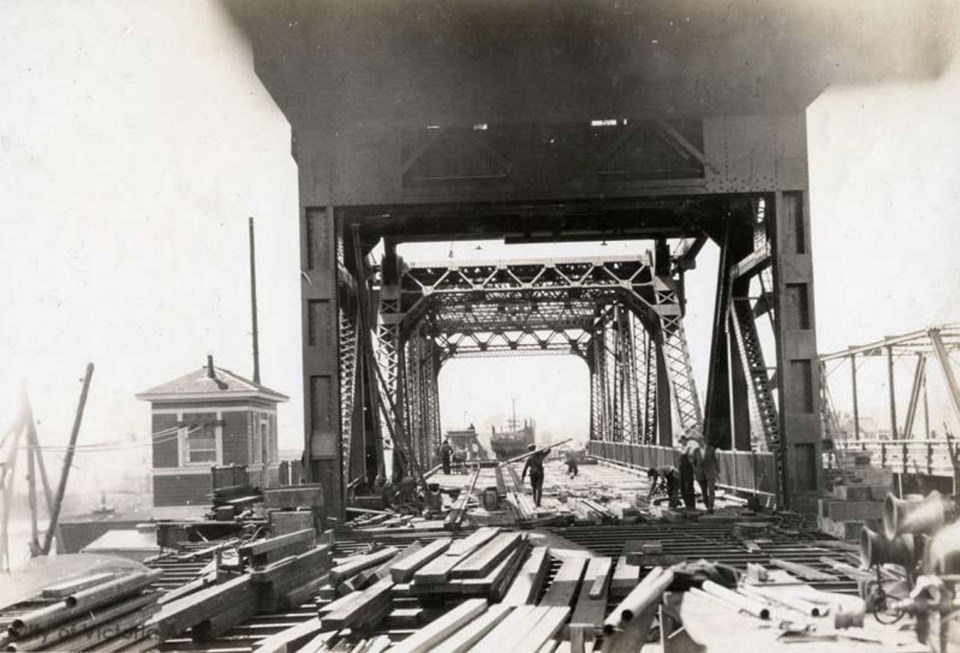 Two short bridges, built almost a century apart, have more in common than users might think.The old Johnson Street Bridge and the new span that is replacing it were both opened after long, tedious battles, cost overruns and delays. In Victoria, it seems, we take our time with these things.
Two short bridges, built almost a century apart, have more in common than users might think.The old Johnson Street Bridge and the new span that is replacing it were both opened after long, tedious battles, cost overruns and delays. In Victoria, it seems, we take our time with these things.
The new bridge, which opened March 31, started carrying traffic more than nine years after the first public mentions of problems with the old span.
That is less time than it took to create the blue, formerly black, bridge that has been closed and is awaiting demolition.
The old bridge opened on Jan. 11, 1924, and replaced a rail-only swing bridge that had opened in 1888 to carry the Esquimalt and Nanaimo Railway in and out of downtown Victoria.
There was talk of a new bridge in the early 1900s, and pressure grew more intense in 1911, after the land across the water from downtown was bought from the Songhees First Nation.
The hand-operated swing bridge might have made sense in 1888, but it could not meet the needs of a modern city. It did not have space for horse-drawn carriages or motor vehicles, and pedestrians making the crossing had to walk on the tracks. Esquimalt Road traffic crossed the water at Point Ellice.
Long before the new bridge was approved, the City of Victoria decided that the work would be done by Joseph Baermann Strauss of Chicago. Council considered plans for the bridge for several years. In 1914, voters approved improvements to the old Rock Bay bridge, at the foot of Bridge Street. For motorists and horses, it provided the shortest route between downtown and the Point Ellice Bridge, the gateway to the western side of the water.
Those fixes were a good move, as the Johnson Street Bridge was delayed by the financial downturn of 1913, and then by the Great War. It became one of several local projects — the old Bay building being perhaps the most visible example — to be suspended until after the war.
Politicians and officials from the Esquimalt and Nanaimo Railway still had to wrangle over the project’s details and costs, and plans got no further than the drawing board until finally, in 1919, all stakeholders agreed to a plan.
The E&N agreed to contribute $100,000 to the project, and would cover one-third of the operating costs. The province chipped in another $200,000, leaving the city to borrow $420,000 to complete the work.
The idea went to Victoria’s voters in January 1920, and was approved by a huge margin.
“By a landslide majority — probably the biggest ever rolled up in favour of an important bylaw in Victoria — the Johnson Street Bridge was endorsed at the polls yesterday,” the Daily Colonist reported on Jan. 16, 1920.
Voting for the bridge were 2,984 people, while 443 were opposed.
The bridge, with a price tag of $720,000, was seen as a major factor in the expansion of Victoria. With a bridge in place, the Songhees land could be put to industrial use.
“The passage of the Johnson Street Bridge bylaw removed the last obstacle in the way of the industrial development of the former Songhees Reserve area,” Premier “Honest” John Oliver said. He added that the province had already spent almost $1 million on the Songhees property so it could be made available to industrial establishments.
Not all of the details had been locked down. The deal approved by voters called for a single bridge, to be shared by the railway, vehicle traffic and pedestrians. In the end, we had two bridges, side by side.
The agreement with the railway dealt with financial matters and the operation of the bridge — for example, it was not to be opened within 20 minutes before or after the scheduled arrival of a train.
After the bylaw was approved by the voters, Strauss was officially hired to design the bridge. The first shipments of lumber for caissons arrived on site and construction began. There were guesses about when the bridge would open.
But it wasn’t as easy as that.
The bascule-style bridge soon became synonymous with escalating costs, and by May 1922, the money ran out. The city was forced to go back to the voters, this time to ask for an additional $110,000 to complete the work.
In an editorial on the day of the vote, the Daily Colonist strongly endorsed the project.
“That structure, now so far advanced, must be completed,” the editorial said. “The citizens want the new traffic highway to be in operation before the end of the present year.
“Its installation will lead to both business and industrial development. It will be a boon to residents of Victoria West and Esquimalt by giving those centres of population closer connection with the business area of this municipality. It will undoubtedly also have an excellent effect on the development of the industrial area formerly known as the Songhees Reserve.”
The borrowing bylaw was passed by a wide margin, and work on the bridge was allowed to continue.
Almost two years later, the bridge was ready.
“Victoria today entered into the realization of a long cherished dream,” the Victoria Daily Times reported on its front page on Friday, Jan. 11, 1924.
“The opening of the highway section of the Johnson Street Bridge not only gave direct communication to the western suburbs but it has rendered possible the efforts of successive municipal bodies over a long term of years to have a trunk thoroughfare from Oak Bay direct to Esquimalt.”
The official opening ceremony was at the eastern end of the bridge, the downtown side. A stream of dignitaries gathered on a small platform, built for the occasion, to hear Mayor Reginald Hayward declare the new crossing open.
“Criticism has been expressed in various quarters in connection with this enterprise,” Hayward said. “Many obstacles were met and had to be overcome by those to whom the project was entrusted, thus adding very much to the cost of the structure.
“We have now, however, an excellent bridge thanks to the faithful work and ability of the engineers, linking up the Songhees Reserve industrial area, Victoria West and Esquimalt. This state of affairs has been desired. It is now an accomplished fact. Let us make the best use of it we can and unitedly endeavour to turn the investment into a good paying proposition.”
Premier Oliver joked that he would not “wish to change places with the engineer, who had to explain to the council the extra cost of the bridge.”
He added that “the excess cost of the work above the engineer’s estimate was a very common occurrence today. The excess cost was about 27 per cent above the estimate while frequently the experience was that the excess was 50 per cent on public works.”
Officially, the ceremony dealt only with the highway portion of the bridge, not the railway portion, but it was timed to coincide with the arrival of the train from up-Island. That meant that as soon as Hayward and the others finished speaking, traffic moved right away on both spans.
By opening the bridge’s twin spans, industries such as sawmills and shipyards could have water access. When the spans were down, the bridge provided land access for freight traffic between the E&N yards and the warehouses and industries on and near Store Street downtown.
The bridge had wooden decking when it was built. The wood was replaced with an open steel grid, which was lighter on rainy days, in 1966. The bridge was painted black for 55 years, but was given its light-blue paint job in 1979.
Like its replacement, the 1924 Johnson Street Bridge came into being after controversy, cost overruns and delays. Those worries were forgotten as time passed, and the bridge became a feature of Victoria’s waterfront, even before it became known as the Blue Bridge.
Dave Obee is the publisher and editor-in-chief of the sa���ʴ�ý.



